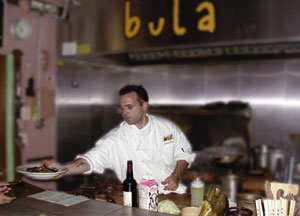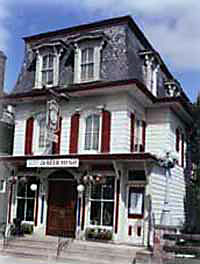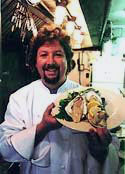If you're looking to go out to eat (or drink) in New Jersey you have 21,000 choices. In fact, with 200,000 workers, eating and drinking establishments join to become New Jersey's largest retail employer. The contest for your dining dollar is fierce. One in four retail businesses in New Jersey wants to sell you food and drink! Competition exists between restaurants across the street, from one town to the next, regionally, across state borders, and from one industry segment to another. The number of restaurants and taverns has increased 40% in the past ten years, a large part of that growth from chains and franchises. Alternative "Wegman-style" meals have brought even supermarkets into the restaurant game. For the independent owner, the challenge has never been greater.

"In general, competition makes for better operators," comments Deborah Dowdell, president of the 61 year-old New Jersey Restaurant Association, the state's dining industry advocate. "As long as all the players are launching from a level playing field, competition is good for business and good for the public.
"We compete for labor. We have to keep a close eye on our food costs. We are a heavily regulated industry, from health to taxation to labor to liquor licensing. We operate on slim margins, 1-3% net profit according to the National Restaurant Association. We're in a very expensive media market and our insurance rates are astronomical."
New Jersey's high property taxes, high cost of living, high labor and insurance costs, and stubborn dedication to home rule make it tough for any small business here. Hospitality-based businesses are subject to an expensive liquor licensing system and a never-ending list of state regulations. National legislation such as the tax non-deductibility of business lunches has dramatically hurt industry profitability, as have general trends like the decline in alcohol consumption. And restaurants are among the first to suffer in economic downturn.
"I often find that New Jersey restaurant operators are regarded as feisty competitors. If you're in the competitive mode, you want a New Jersey restaurant operator on your side," Dowdell continues. This is particularly true during the legislative process. When elected officials consider regulations that will impact the industry rules requiring dietary ingredients on menus, a prohibition on serving water without a request, and, of course, alcohol and smoking regulations the state's restaurant operators are closely engaged in the process. Ann Hall, NJRA board member and owner of the Ship Inn Restaurant and Brewery in Milford, a tiny Hunterdon County village on the Delaware River, is well aware of legislative hurdles in the hospitality industry. She successfully negotiated a maze of legal issues and opened New Jersey's first brewpub nearly 10 years ago. Restrictions are there obviously for the public's benefit, but she says in many cases "we want customers to make the choice and not have to be the bad guy or the good guy."
The influx of well-heeled competition from franchises has not made the independent restaurant owner's job any easier. Although most "fine-dining" operators don't see the chains as direct competitors, the proportional change in independents to franchises impacts the dining pattern. The portion of the consumer's out-to-eat budget available to independents is shrinking. The Council of Independent Restaurants of America states the challenge to Independents more urgently: "Whether you are a neighborhood bistro, a four-star restaurant, or the trendiest place in town, you are in danger of closing for good. In the battle for market share, the national chains are mounting a well-financed, aggressive assault on the nations' major restaurant markets. They have the money to command prime real estate, they have the marketing dollars to saturate the market with publicity and advertising, and they can even sustain losses for a long period of time. If the dinner-house chains have their way, the dining scene in most cities will soon offer the limited choices that consumers now find in shopping malls throughout America: the same 30 or 40 stores in every location."
 |
| Top of the Green Restaurant at Apple Mountain Golf and Country Club |
National chains prosper with the same basic menu items because they have operations down to a science and provide a consistent formula of food and service that customers can depend on. Conversely, the successful Independent uses freedom from those very guidelines as a crucial advantage, making dining at a new restaurant a wonderful adventure. Independents can hone their own styles and change their menus whenever they please. Patrick Hyland, Executive Chef at Top of the Green Restaurant at Apple Mountain Golf and Country Club finds the freedom invigorating. "I love to be creative with food," he says. "I enjoy it when people want me to create a dish just for them, whether it's because they are on a special diet or simply because they want to try something totally different. I see it as a gift. I will accommodate special orders anytime. It's a challenge that I thoroughly enjoy." But if prices aren't in line with the chains, most Independent's advantages when it comes to menus, service and customer loyalty don't mean much. Owners must watch their cash flow and bottom line closely; there is no wiggle room.
Independents assume enormous risks: failure in any area staffing, supply, regulatory compliance or menu and ambience creation can sink a budding restaurant faster than a gas-filled zeppelin. With that burden, they must also develop successful marketing campaigns to draw in customers. For most, the key determinates of their marketing strategies revolve around their location, branding, and targeted clientele. For start-ups, even the most skilled professionals face a road so long and perilous that franchise branding can make all the difference. It can take years to build a loyal customer base large enough to sustain a business. Battles for independence are often won, but the war isn't being fought in the kitchen. It's being won by the franchise Director of Marketing, who can spend the big bucks in radio and television, and big, beautiful four-color print ads that guarantee a pretty good time at a pretty good price. Your cost for dinner may not be all that different from the one you'd pay anywhere else, but it's the perception that counts.

Yet independent restaurants remain integral parts of most communities, many of which have undergone a renaissance using dining destinations as the catalyst for transformation. Large downtown centers like Morristown, Newton, Phillipsburg and Somerville have come to rely on independent restaurants as attractions much in the same way as more traditional "visitor destinations" like Lambertville, Frenchtown and Milford. Good restaurants are a vital step in reinvigorating, distinguishing and promoting a community. And there are no more creative and tenacious business owners than those that operate restaurants. "Promotion is a full time job for independents. 90% of my time is spent doing stuff that will promote the restaurant or create special events that will raise awareness," says Hall. Every step she takes brings attention to all the other things surrounding her grand old building on Bridge Street.
Young Blood

At the other end of town, chef-owner Ed Coss runs the Milford Oyster House. Besides all his responsibilities as a business owner, Ed also plans an extensive list of weekly specials, cooks and plates each meal to order, and tends to his on-premise fish store. The market guarantees patrons the freshest possible seafood, generates another revenue source for the Oyster House and even enables Coss to cater to special requests for private affairs.
Coss is one of several young chef-owners who make the local dining experience fresh and exhilarating. They are most able to combine cuisine with personality and the management efficiencies necessary to scratch and claw to the plateau of profit. Often classically trained and with extensive apprenticeships, they bring a passion and sophistication that we normally associate with "big city" dining. And they have panache. Coss, Bradley Boyle, Andres deWaal, and Tim Schafer, all of whom graduated from the Culinary Institute of America in Hyde Park, NY, within a few years of each other in the '80s, have risen through the ranks and returned to NW New Jersey as owners of fine restaurants. Boyle and deWaal are just a few doors away from each other on Spring Street in Newton, bringing a cosmopolitan attitude to the Sussex County seat. Andres, who was voted most likely to succeed from his class at C.I.A. has enjoyed lofty praise from The New York Times for his innovative European-American menu. Besides a large and loyal clientele for dinner, deWaal draws crowds for his regular series of cooking classes, where he offers intimate glimpses at his mastery. Steps away, Boyle's Bula World Cuisine offers guests a variety of dishes from a menu that constantly changes and might on any given day include European, Asian and/or Caribbean entrees. Bula's atmosphere exudes a cool confidence; comfort that you've made a good choice when you walk through the door.
In Hope, New Jersey, isolation creates a dilemma for Charlie and Cordie Putkammer, the owners of The Inn At Millrace Pond. Their compound of lovingly restored 18th century stone buildings in the heart of the village deliver over the top curb appeal in a rural community with little traffic. Each building, a restaurant, inn, and conference center, supports the others, aesthetically and functionally. With 17 rooms at the Inn, and a regular restaurant capacity of 66 (up to 90 for parties), the Putkammers had to expand the reach of their potential market.
Hope has historically attracted diverse groups, from nature lovers to history buffs. The Putkammers are happy to keep the niche groups. The converted, two-story mill, with its first floor tavern and second floor restaurant, appeal to a broad client base. Long after autumn colors have faded away, members of the Third Regiment New Jersey Civil War Reenactors crowd the tavern for their Annual Dinner. They come for the food as well as the décor. The menus range from the simple dishes in the tavern to more elaborate meals in the upstairs restaurant. Entrees have included rack of lamb, breast of duck, and New Zealand venison. Addressing both current dining trends and modern needs, vegetarian dishes and entrees for children found a place on the menu. When the inn hits an off season, and out of state clients develop an aversion to snow-covered roads, the kitchen continues to draw customers. Nonetheless, although word-of-mouth advice delivers clients, the Putkammers can't afford to take business for granted.
Among the winter promotions, the Inn offers a fixed price Valentines Day menu. Dinner coupons also appear in the New Jersey Entertainment Book. Raffled or auctioned off at charity events, a coupon offsets the cost of an entrée by $25. "We might make some money on the bar and the desserts," Charlie says. "We really do it in the hope that they will enjoy the experience and come back."
Modern promotional vehicles augment their traditional advertising efforts. As winter descends on Hope, the Inn's website provides a constant visibility. The Putkammers also derive marketing benefits as member innkeepers at Select Registry™, an organization created to promote quality inns. Visitors to the registory's website can search for lodging by state and will find links for the Inn within the site. Subsequent maintenance has been so easy the website is sometimes a forgotten strategy, but additional links to the Inn's home page continue to grow. The extraordinary scope of the web has given the Inn an international advertising presence.

Near the busy towns off Route 78, Elaine and Russell Mayer run The Glen Gardner Inn. Like the Putkammers, they branded their restaurant around a historical site in this case an 18th century wood tavern with the oldest continuous liquor license in the state of New Jersey. In their case, however, the surrounding towns offer a greater pool of potential clients. The Mayer's advertising strategy focuses less on aggressive multi-media advertising than it does on active participation in local events.
Striving to create a homelike atmosphere, Elaine meets and greets customers. Reaching over the bar, Russell Mayer's handshake has the force of a blacksmith's grip. Their welcome is both a source of personal pleasure and a part of their business strategy. Anxious to avoid overextending themselves or lowering the restaurant's quality, they limit dinner hours to five nights out of the week (Wednesday to Sunday), and try to attract diners from the local community. They place an emphasis on community relations and personal interactions, to which the Mayers seem ideally suited.
Their local pro bono work, and a history of providing modest gift certificates for community functions, has helped create a loyal customer base. Recipients of the Mayer's community involvement have been along the lines of the local volunteer fire company, the girl scouts, the Special Olympics and the Oldwick Fall Festival. Within the restaurant, special events such as the Valentine's Day menu draw in more customers. Like their counterparts at The Inn at Millrace Pond, the Mayers focus on providing a quality menu, with items like certified angus beef, Australian lamb, butternut squash soup, a pan seared Hudson valley foie gras over caramelized apples, and sea bass with saffron risotto. The tap room offers an extensive wine list, with items like 15-year old, single malt whiskeys.
In Clinton, different traffic patterns create dramatically different advertising strategies. Nestled in a row of shops on Clinton's main street, the Tomato Café pulls in visitors to the Hunterdon Historical Museum and the Hunterdon Museum of Art. Manhattan day-trippers on weekend sightseeing excursions mix with antique enthusiasts; visitors stop for meals at various eateries along the quaint main street. They frequently head for the cozy restaurant with its whimsical, tomato driven décor. Once past the deceptively narrow entrance, guests find a restaurant with an indoor capacity of 75. The predominantly Italian menu also offers spa selections, with reduced caloric, fat and cholesterol content. In keeping with its family-friendly ambience, Tomato offers a children's menu and booth seating.
For many of the establishments on the main street, the volume of sightseers has reduced the pressure to create individual advertising campaigns. (The website for Tomato Café is still under development.) Instead, owner Jimmy Kaptain reaps the benefits of the promotional efforts of the Clinton business community, otherwise known as The Clinton Guild. Aggressively engaged in attracting business, the Guild organizes promotional events through the year. Wine tastings, outdoor concerts, civil war encampments, and antique shows represent a small part of the activities. In the winter, Sweethearts Week dominates the February calendar; Luck of the Irish programs run from March 10-17. With its targeted local, regional, and web-based campaign, The Guild's success helps offset the competition between restaurants, although Jimmy makes occasional contributions to local churches, silent auctions and raffles (dinners for two), and donations to the cancer society to further to his restaurant's visibility.
In such a high traffic area, the advertising tactics of street-front restaurants are sometimes as subtle as passive solar heat. Early arrivals often find themselves seated by sidewalk windows, giving a lasting impression to passers-by of a successful, rapidly filling restaurant. Nonetheless, Jimmy Kaptain cannot afford complacency. The harsh reality of the risks incurred in managing an independent restaurant hit when he was sidelined to deal with health problems. His partner, Chip Kurutza, was crucial in managing the day-to-day concerns. It is an approach repeated in the kitchen, where daily specials augment a core menu. To manage risk exposure, their team of chefs function interchangeably. If one falls sick, the others can pick up his tasks. The consistency of Jimmy and Chip's partnership, staff relationships and the Guild's marketing proved equally indispensable.
While advertising and promotional strategies can be as different as the independent restaurants are from each other, the business struggles remain the same. With competition, health, staff and location issues to contend with, independent restaurateurs learn quickly that a well-planned advertising campaign can minimize their risk exposure. A reliance on strategically placed real estate, local ads and word-of-mouth remains the building block of promotional efforts. Today's marketing strategies must encompass different communication tools to reach a larger world. Whatever works... in the end it's the food that brings them back.